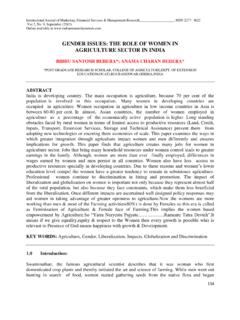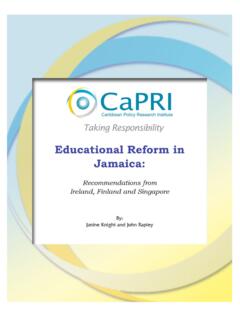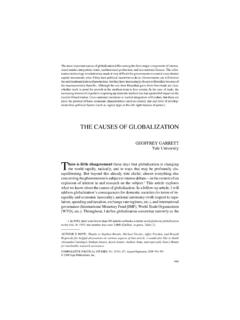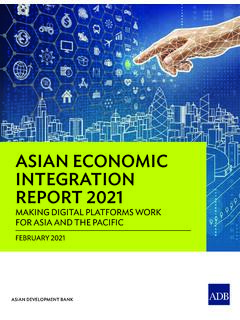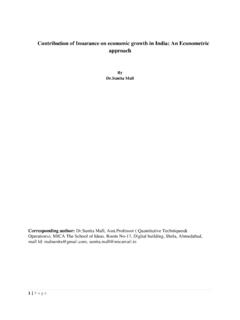Transcription of Migration and Globalization: Challenges and Perspectives
1 24 Conference Proceedings | 7-8 April, 2017 globalization - economic , SOCIAL AND MORAL IMPLICATIONSDOI: and globalization : Challenges and PerspectivesPhD Prof. Mariana B lan Athenaeum University of Bucharest, Romania andInstitute for economic Forecasting- NIER, Romanian Academy E-mail: The globalization of modern world stimulated marked increases in the Migration to locations both near and far supported by several factors either of economic , social or environmental nature or by political instability and the development of some sophisticated, modern transport systems and networks that facilitated easier, cheaper and quicker movement of individuals than in any other moment in mankind s history. Thus, the number of international migrants reached 244 million in 2015 on increase by 41% as compared with the year 2000. Characteristic for the Migration phenomenon by the end of the 20th century and the beginning of the third millennium is the change in the structure, dimension and typology of Migration flows, as the workforce demand regarding the labor force market in the countries of destination is addressed especially to high-skilled immigrants.
2 Even though for most of the times, the volume, diversity, geographic expansion, as well as the general complexity of international Migration are considered as on increase as effects of the globalization processes, still this idea remains for its largest part unverified. The paper presents a brief analysis of the main globalization characteristics of globalization and its impact on the volume, structure, and trends of the Migration : globalization , Migration , urban immigration, economic and social effects JEL Classification: F22, J10, J21, J24, J61, O15, R23 globalization - economic , SOCIAL AND MORAL IMPLICATIONS25 IntroductionGlobalization increased the interconnectedness of national states, accelerating the flows of goods, services, ideas and people beyond national borders. International Migration was present earlier than globalization but the speed, scale, complexity and volume of world Migration within the global era remains flows of goods and capital were made possible by gradual lowering the barriers to trade and investments beyond national frontiers during the last decades and allowing thereby for the expansion of world World Bank Report globalization , Growth and Poverty 1 indicated that while countries pursued to promote integrated markets by liberalizing trade and investments, these elaborated a series of policies which were, to a large extent, opposed to Migration liberalization.
3 However, despite governments reluctance to liberalize policies in the field of immigration, the number of individuals living outside their countries of origin increased from 120 million in the year 1990 to 244 million in the year 2015, a figure representing of the world increase in social, economic and cultural links between countries facilitated Migration for an increasingly larger number of individuals and the diversification of this phenomenon regarding structure of these immigrant populations not only of the countries of origin, and with respect to Migration types: for labor, education, family and asylum, temporary Migration and permanent Migration coexisting increasingly determinant factors of international Migration are diverse and complex. From the reasons classified as push and pull factors, globalization imposed the implementation of a third set of motivations under the designation of network , which includes the free flow of information, improvement of communication at world level, along with swifter and cheaper transport.
4 These latter factors are not a direct Migration reason, but elements contributing to favoring Migration . It should be noticed that modern globalization is not determined only by the technological progress, but also by the political and ideological globalization , Growth, and Poverty: Building an Inclusive World Economy, The report is written by Collier P., Dollar D., World Bank Publications, 2002 Conference Proceedings | 7-8 April, 201726 Regarding the contemporary geography of labor force Migration , this one mirrors the globalization of world economy and of the labor force markets, where an increasingly higher number of countries turned into participants to the Migration systems at world level. A globalization of international labor force Migration takes place, and the increase in the numbers of countries involved in the Migration systems triggers an increasing higher diversity of the the framework of globalization , enterprises increase and become more internationalized and, often, these externalize their production to developing countries where the labor force costs are smaller.
5 This movement of jobs from developed countries to developing ones attenuates some of the economic factors generating effects of Migration are complex, as they bring both benefits and disadvantages, both for host countries and origin countries. Immigration provides a source of cheap labor for host countries, a resource for diminishing the effects of demographic ageing, while remittances of migrant workers might represent an important income sources for relatives remaining in the country of origin. On the other hand, immigration may generate resentments and fear against the newcomers in the communities. For the economies of the countries of origin, emigration generates losses of working age young individuals who are well-educated and to a more substantial population ageing. Quantifying the direct or indirect impact of globalization on international Migration is a difficult and complex task. The studies realized with this purpose highlight that globalization favored both legal and clandestine flows of migrants, these generating benefits and problems/ pressures in origin and host these combined trends suggest that the Migration models at world level became increasingly General characteristics of globalizationGlobalization is an extremely complex and controversial concept, yet not a new phenomenon, but a continuation of current socio- economic developments.
6 Among the most significant characteristics of globalization in the current conjecture, might be reminded: globalization - economic , SOCIAL AND MORAL IMPLICATIONS27 i) internationalization of manufacturing accompanied by changes in its structure; ii) expansion of international trade and services; iii) expansion, diversification and deepening of international capital globalization phenomenon is synonymous with the one of acceleration, which is found in vast technological changes, global economic integration, but also in the massive changes of the manufacturing systems and of the labor force markets. globalization lays particular emphasis on the openness of frontiers between countries, and the economic one encourages free trade agreements between countries, multinational corporations and a free flow of goods in the entire technological changes of the last decades affect the product parameters and flows between countries.
7 Improvements taking place in the transport networks and in technology have diminished the transport costs, and the performances in the field of information and communication technologies have facilitated the access for many individuals to a higher volume of available information, at very low costs. These have important implications regarding the nature of manufacturing activities, of knowledge flows, but also on trading the realized products. Thus, economic globalization prospers due to advanced digitalized technologies that facilitate the global expansion of companies, allowing them to optimize their operations and their aggregation on the world market while at the same time saving costs for these the same time, economic globalization has as purpose also the incorporation of peripheral regions within a single global economic system unhindered by domestic , the globalization process is a controversial one.
8 The supporters of this process allege that globalization supported by economic policies liberalization and by technological process generates important benefits, such as: improving the allocation of resources; increasing competitiveness, wider consumers choice, increasing the possibilities of accessing international capital and investment markets, and access to ideas, technologies and performance , in favor of these arguments are but few evidences. Thus, if the GDP growth rates are analyzed at world level, for the last decades of the 20th century and the beginning of the third millennium, these are still lower than the ones by the beginning of the seventies, when financial liberalization began. At the same time, Conference Proceedings | 7-8 April, 201728the weight of investments in GDP at world level was, by and large, low2 and indicating the intention to realize long-term promoters of globalization support the idea that the liberalization of commercial markets and of the capital account led to higher efficiency in resources allocation.
9 If, with respect to the liberalization of commercial flows several studies were realized which bring to the fore strong empirical evidence in support of this statement and of their benefits, still analyzes regarding the significant benefits generated by the liberalization of the capital account does not provide for systemic evidences. The fact that the liberalization of the capital account is a much more complex process than the liberalization of commercial flows was highlighted also by the experiences of many developing countries that were faced with the financial crises of the last years. Some experts3, regard globalization as being an extremely unequal process. For instance, growing trade is not leading to more equitable distribution of underlying comparative advantages. Inequalities exist also regarding the entries of foreign direct investments, and in generating new knowledge (a relatively small number of countries continue to dominate in innovation).
10 Winners and losers of the globalization process are found both at the level of the various countries of the world, and at the level of some population segments within the same country. The increasing inequality between countries generated by the globalization process is highlighted also by the differences between the income per capita in the richest and the poorest countries. Thus, according to the World Bank statistics, in 2015, the gross domestic product (at purchasing power parity) per capita, between the two richest countries Qatar and Luxemburg, was of 141543 Int$, respectively 11497 Int$, while in the poorest countries, the Central African Republic and Burundi, it was of 619 Int$, respectively 727 Int$. The fact that some countries are the winners and others the losers of the globalization process, indicates also that significant differences exist in their capacity of mitigating efficiently the Challenges of globalization .

